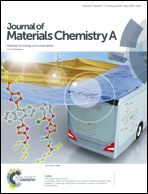High energy Li-ion capacitor and battery using graphitic carbon spheres as an insertion host from cooking oil†
Abstract
We report a facile low-temperature synthesis of graphitic carbons with a spherically shaped morphology (CO-CS) and high purity by the modified catalytic chemical vapour deposition using vegetable cooking oil as a carbon source. The excellent Li-insertion properties are noted with high reversibility (∼369 mA h g−1) in the half-cell assembly, which is very close to the theoretical capacity of graphite. Further explored the suitability to be used as an anode in the practical configurations, the intercalation type LiFePO4 and double layer forming activated carbon (AC) have been used as the cathodes toward the fabrication of Li-ion battery (LIB) and Li-ion capacitor (LIC), respectively. Prior to the LIC assembly, CO-CS has been pre-lithiated electrochemically. Both LiFePO4/CO-CS and AC/CO-CS assemblies display a maximum energy density of ∼337 and ∼108 W h kg−1 (based on an active material loading), respectively. The obtained values are better than those of the state-of-the-art LIB and LIC based on a graphitic anode. A decent cycle-ability is also registered for both cases.



 Please wait while we load your content...
Please wait while we load your content...